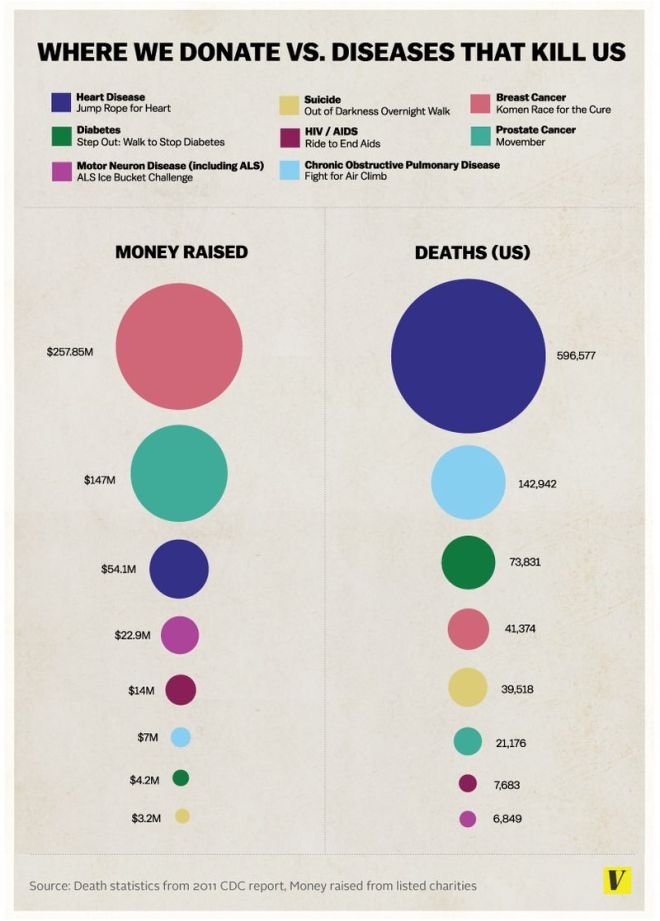We’ve gone through a lot of cognitive biases recently, but one we haven’t talked about is the idea of mental accounting or budgeting. The idea here is that dollars are fungible: your picture of a dead president and/or founding father on special paper can be exchanged for rent, coffee, donations, whatever. In fact, money says that right on it: THIS NOTE IS LEGAL TENDER FOR ALL DEBTS, PUBLIC AND PRIVATE.

Image credit. Dollah dollah bills, yo.
But that’s not how we think about money. In our minds, we have special categories for each type of expense. Think of it as separate jars into which we are putting our invoice: $1400 for the mortgage, $800 for food, etc. We experience mental pain every time we have to rob from one cookie jar in order to put it into another, so we try not to do it.
Picture how you think of money; it probably is something like this. In fact, some budgeting software (we use You Need A Budget at Direct-to-Donor Manor*) formalizes this process to make sure you don’t overspend in a category. We get comfort from knowing that each month, there is $X set aside for eating out.
Your donors think this way also. Somewhere in their minds, there are mental Mason jars with “CHARITY” written on them. There may even be several such jars: one for each organization they support.
If you think of how your donors mentally account, the implications ripple outward. This is part of why:
- It’s far easier to retain a donor than acquire one.
- People who have donated multiple times don’t like to be asked for gifts other than what they’ve given in the past, while one-time givers still have fluidity.
- People who donate to a particular campaign are more likely to give to that campaign again the next year, especially when reminded that they did support last year’s campaign.
- We are going to have a challenge as non-profits until we can figure out how to get people to expand or create their charity cookie jars, rather than trying to get them to get a greater share of what it is that jar for our own organization.
So how do we diminish the pain that a donor feels from robbing from their “movie” or “eating out” or “savings” mental accounts to give to us? Part of this, as mentioned previously, can be framing the gift against the frivolous. But another technique that breaks through mental accounting is framing your ask as an exception expense.
One quirk of mental accounting is usually there is an “incidentals” budget. This is a “what happens if my 2003 Saturn Ion** chooses to give up the ghost today” contingency fund that we can dip into.
One study changed the frame on their annual event. Instead of talking about their walk as an annual event that happens every year, they talked about it as an event that only happens once per year.
You have to admit, there is hardly any difference between the two of these phrases (and it’s always nice to run a test that will slip unseen past your Brand Police).
Yet the results were impressive. By running Google Adwords with the new, unique, once-per-year framing, study participants said they would participate in the exception version at a 46% rate, compared with 35% for the annual framing. When they ran the ad for real, people were 11% more likely to click on the exception framing ad.
Similarly, in the mail:
“This mailing is part of a special charity drive that happens only once a year. Alex’s Lemonade Stand is requesting only one donation a year going forward.”
Beat:
“This mailing is part of a regular charity drive that happens annually. The charity is requesting a donation every year going forward.”
Some implications of this research:
- This can help immensely with your event advertising (and you are trying to get your direct marketing donors to your events and vice versa, right?). But for us, we also are testing removing things like “10th annual” from the press activities around an event. The idea of themes could also be potent as a way of differentiating this year’s event as its own unique snowflake.
- This could explain part of the effectiveness of techniques like a membership campaign and a better way to frame said campaign: “this is the one special time of the year we ask all supporters to make their membership gift.”
- This may explain as to why scarcity, urgency, and uniqueness are effective persuasive levers. It’s challenging to use this framing if you are sending four to 24 letters per year, and your donor knows that. However, techniques that increase urgency or uniqueness like matching/lead gifts, deadlines, urgent petitions, etc. can help give a reason to open the piggy bank.
This may seem to contradict the idea of consistency – that people give to the same campaign year after year. I would argue that they complement each other. If you are trying to get someone to do what they’ve done before, play back their previous history and lean into the fact that you and they have a history. If you are trying to get someone to try something new, you have to figure out for them which jar to take it out of and why.
So go forth and be unique in your messaging; it seems to be a better strategy that appealing from the tried and true.
* I have received no endorsement money or considerations from You Need A Budget. But I’m open to it!
** This is absolutely your author’s ride of choice. As I mentioned in the post where I outed myself as overhead, the life of a nonprofit person should be neither Bentleys or ramen.




 The stories differed only in detail. Half received irrelevant details for the good side: e.g., instead of just “Mrs. Johnson sees to it that her child washes and brushes his teeth before bedtime,” they added “He uses a Star Wars toothbrush that looks like Darth Vader.”
The stories differed only in detail. Half received irrelevant details for the good side: e.g., instead of just “Mrs. Johnson sees to it that her child washes and brushes his teeth before bedtime,” they added “He uses a Star Wars toothbrush that looks like Darth Vader.”
